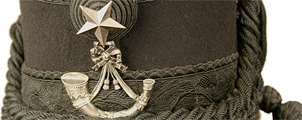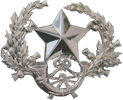Volunteering with the Scottish Rifles (Cameronians) Regimental collection
The week beginning 2nd of June was Volunteers Week and we decided to ask one of our long-term volunteers a few questions about his time with us and his work with the Scottish Rifles (Cameronians) regimental collection. Volunteering has a very special place in our regiment’s history as it had a long tradition of brave men who joined the Territorial Army and Volunteer Reserve.
Brandon is a military history enthusiast who is currently studying Social Sciences at New College Lanarkshire. He has done some amazing work for our blog, researching the men behind the medals and it is always a very bright and pleasant day when he comes to our museum.

Interview:
How long have you been volunteering with us, Brandon?
A year and 3-4 months.
Is this the first time you have volunteered?
Yes.
Why did you decide to volunteer at our museum?
I was on a course, a RISE course, where you get help finding your future plans and, because I was always interested in history, I wanted to look into working with libraries or museums. In the end, I thought museums were the better fit for me.
Had you visited this museum when you were young?
Yes, but when I was very little.
Why did you decide museums were better than libraries?
They have a closer link with military history.
What did you expect volunteering would be like? Was it different than what you thought?
I didn’t really have expectations when I started. It was better than I thought, certainly. The work environment is very good and everyone is very nice. It’s a combination of the collection material and the people who support me that made it a successful experience.
Did you know of the Cameronians (Scottish Riffles) regiment before you began your time with us?
No, but I was always fascinated by military history and knew of other Scottish regiments.
What is your favourite fact about our regiment?
I really like how it is more linked with the working class of Scotland and that the soldiers were often everyday Scottish people who volunteered to take part.
What is your favourite object from the regimental collection?
I really like the military medals. They tell the stories of people who often weren’t officers, but their brave actions granted them the recognition they deserved.
I know that you have always liked military history. Has your perspective on this side of history changed after helping us at the museum for over a year?
I am a lot more appreciative of what the soldiers did. It is a lot more than I ever knew from their beginning. It makes me proud to be Scottish when I learn of all they did and the part they played.
What is your favourite era of our regimental collection?
World war 2 is the most interesting part of the collection. It’s the freshest in my mind. Everything that happened in the western front. You think of all the sacrifices and the people who died and how we have records that commemorate this. And you get to see the changes of the medals from WW1 to WW2. For example, for WW1 medals, the soldiers names were on them but for WW2, this wasn’t the case. I am just fascinated by this change and the possible reasons behind it.
You really find an interesting strand of social history in our collection?
Yes, it is a lot about class. I am fascinated how the same actions would grant different medals to officers and to private soldiers or volunteer soldiers. Class is a big part of medals, in my opinion. Social class is something that I was always interested in because it can divide and separate very easily.
What do you do as part of your volunteering?
Helping with inventory and writing blog posts.
Which is your favourite?
I can’t choose. They go hand in hand for me.
What is the most memorable part of research you did for the collection?
The story of Thomas Scott. His story is really good, and we have letters of him being given the military medal, but he wasn’t alive to receive it. While he was dying, he gave his servant his pocket watch and then the servant possibly returned it because we have it in the museum collection along with other items that relate to Thomas Scott. I just really like that we can see a story through the various objects.
Why do you continue to volunteer?
Because it never gets boring. I am always learning something new about a person or the museum in general. You might do the same thing at times but it never gets boring.
How would you pitch the interest of a regimental/military collection to someone who doesn’t know a lot about this kind of history? What makes it very interesting to you?
The uniqueness of the regimental collection is that we get to examined the people within the regiment in depth. It is almost like a movie and the stuff you read feel unreal, but we know they happened.
What are your future plans?
To work in a museum! Study until I have enough qualifications for a museum to accept me.
Brandon has contributed the following articles for our blog:
Company Sergeant Major John Clark Hannah
Riflemen George Anderson 1084996
Thomas Scott: Second Lieutenant and Adjutant
Comments: 0


